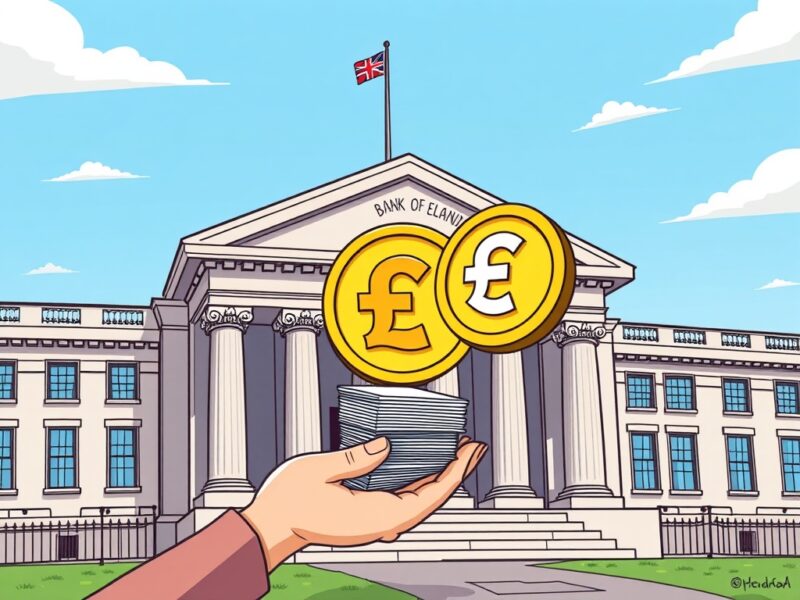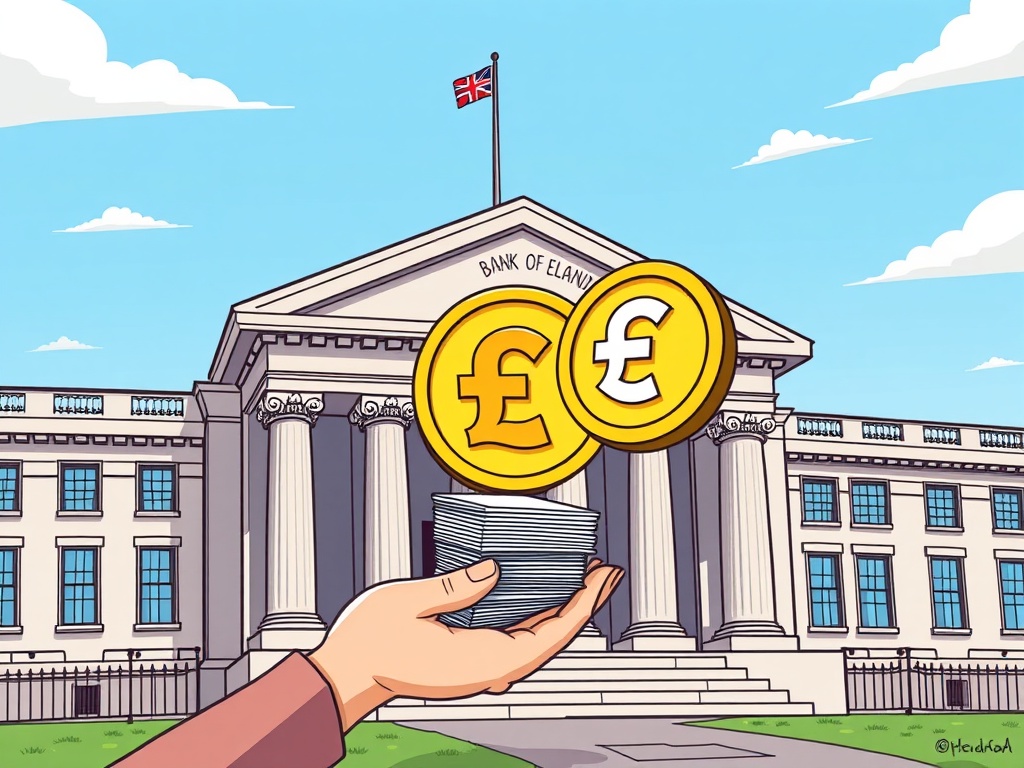Bank of England Stablecoin Move Unlocks New Era for Digital Assets
0
0

BitcoinWorld

Bank of England Stablecoin Move Unlocks New Era for Digital Assets
The world of digital finance is buzzing with a significant development from the UK. The Bank of England stablecoin policy is undergoing a pivotal shift, poised to reshape how these crucial digital assets operate. This move isn’t just a technical adjustment; it’s a strategic decision that could bolster trust and drive innovation within the broader cryptocurrency ecosystem.
What’s Changing with Bank of England Stablecoin Rules?
Bank of England Deputy Governor Sarah Breeden recently made an announcement that has caught the attention of regulators and crypto enthusiasts alike. The central bank is set to relax its existing regulatory framework for stablecoins. This relaxation means a crucial change for issuers: they will now be permitted to hold some of their backing assets in short-term government bonds.
Breeden explained that the framework, initially published by the bank in 2023, was not entirely suitable for the evolving needs of stablecoin issuers. This acknowledgment highlights the central bank’s adaptability in a rapidly changing financial landscape. The initial vision for stablecoins primarily focused on retail applications, but their utility has expanded significantly.
Today, stablecoins are increasingly seen as foundational for settling tokenized securities and other institutional applications. This shift in purpose necessitates a more flexible and robust regulatory approach. The decision by the Bank of England stablecoin policy team reflects a proactive stance to accommodate this evolution, aiming to integrate digital assets more seamlessly into traditional finance.
Why is This a Game-Changer for Stablecoins and Digital Finance?
This policy adjustment carries substantial benefits for the stablecoin market. Allowing issuers to back their stablecoins with short-term government bonds can significantly enhance their stability and trustworthiness. Government bonds are generally considered low-risk assets, providing a strong foundation for the value of stablecoins.
- Increased Trust: Backing with government bonds can instill greater confidence among users and institutions, knowing their digital assets are anchored to highly secure traditional instruments.
- Enhanced Stability: This move helps mitigate risks associated with more volatile backing assets, making stablecoins more resilient to market fluctuations.
- Broader Adoption: With enhanced trust and stability, institutional players, including traditional financial firms, may be more inclined to adopt stablecoins for various transactions, including cross-border payments and tokenized asset settlement.
- Regulatory Clarity: Providing clear guidelines on acceptable backing assets offers much-needed regulatory clarity, which is vital for the growth and legitimacy of the digital asset sector.
This development positions the UK as a forward-thinking jurisdiction in digital finance. It acknowledges the potential of stablecoins beyond simple retail payments, particularly in the burgeoning field of tokenized securities.
Navigating the Future: Potential Impact of Bank of England Stablecoin Policy
The implications of this new policy extend far beyond just stablecoin issuers. It signals a broader acceptance of digital assets within the traditional financial system. While the move is largely positive, it also presents new challenges and opportunities.
Implementing these changes effectively will require careful coordination between regulators, stablecoin issuers, and market participants. Ensuring robust oversight while fostering innovation will be a delicate balance. However, the proactive approach by the Bank of England stablecoin framework suggests a commitment to finding this equilibrium.
This policy could also influence other central banks globally. As jurisdictions compete to become leaders in digital finance, the UK’s pragmatic approach might serve as a model. The shift from retail-focused stablecoins to those used for settling tokenized securities highlights a maturing market perspective, where digital assets are integrated into complex financial operations.
What Does This Mean for the UK’s Digital Asset Landscape?
For the UK, this regulatory relaxation reinforces its ambition to be a global hub for financial innovation. By creating a more accommodating environment for stablecoin operations, the country can attract talent, investment, and cutting-edge projects in the digital asset space. This isn’t just about stablecoins; it’s about the broader infrastructure for future financial markets.
Actionable insights for market participants include closely monitoring the detailed implementation guidelines. Stablecoin projects looking to operate in the UK will find a clearer path to compliance, potentially accelerating their market entry and expansion. This environment encourages innovation while maintaining essential safeguards.
The long-term vision suggests a financial system where traditional assets and digital assets coexist and interact seamlessly. The Bank of England stablecoin decision is a significant step towards realizing that vision, paving the way for more efficient, transparent, and resilient financial markets.
In conclusion, the Bank of England’s decision to permit stablecoin issuers to hold short-term government bonds as backing assets is a monumental step forward for digital finance. It addresses the evolving landscape of stablecoin utility, fosters greater trust and stability, and solidifies the UK’s position as a leader in cryptocurrency regulation. This forward-thinking approach is set to unlock new opportunities for innovation and integration within the global financial system.
Frequently Asked Questions (FAQs)
Q1: What is a stablecoin?
A1: A stablecoin is a type of cryptocurrency designed to maintain a stable value, typically pegged to a fiat currency like the US dollar or a commodity like gold. This stability is usually achieved by backing the stablecoin with reserves.
Q2: Why is the Bank of England changing its stablecoin regulations?
A2: The Bank of England recognized that its 2023 framework was not ideal for current stablecoin uses, which have shifted from primarily retail applications to settling tokenized securities. Relaxing the rules aims to foster greater stability and facilitate institutional adoption.
Q3: What are the benefits of stablecoins being backed by short-term government bonds?
A3: Backing stablecoins with short-term government bonds increases their trustworthiness and stability, as these bonds are considered low-risk assets. This can lead to broader institutional adoption and greater confidence in the digital asset market.
Q4: How does this impact the UK’s position in digital finance?
A4: This move strengthens the UK’s ambition to be a global hub for financial innovation by providing a clearer, more accommodating regulatory environment for stablecoins. It signals a proactive approach to integrating digital assets into the mainstream financial system.
Q5: Will all stablecoins be required to hold government bonds?
A5: The new policy permits issuers to hold some of their backing assets in short-term government bonds. It does not necessarily mandate that all stablecoins must be exclusively backed this way, but it offers a new, highly credible option for reserve management.
Did you find this deep dive into the Bank of England’s stablecoin policy insightful? Share this article with your network on social media to spark further discussion on the future of digital finance and regulation. Your insights help shape the conversation!
To learn more about the latest cryptocurrency regulation trends, explore our article on key developments shaping digital assets and their institutional adoption.
This post Bank of England Stablecoin Move Unlocks New Era for Digital Assets first appeared on BitcoinWorld and is written by Editorial Team
0
0
 Manage all your crypto, NFT and DeFi from one place
Manage all your crypto, NFT and DeFi from one placeSecurely connect the portfolio you’re using to start.




